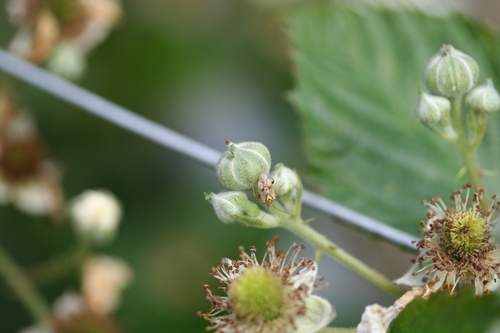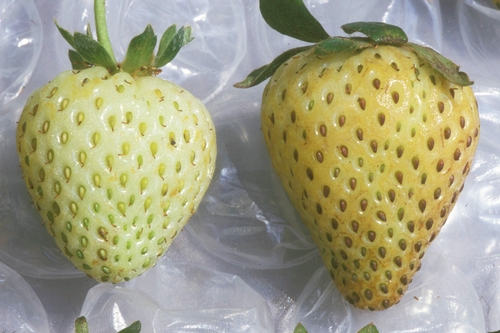Posts Tagged: thrips
MPede and Aza-Direct for Control of Lygus Bugs in Blackberries
As many Central Coast caneberry growers know, this summer season has seen an astonishing number of lygus bugs in blackberries. Counts of 10 to 20 lygus bugs per shake easily rival the heaviest infestations in strawberry.
However, contrary to the “catfacing” or misshapen fruit left by lygus activity in strawberry, there does not seem to be a documented type of damage from lygus in blackberry. All the same, customers have been getting tetchy about having bugs in their baskets of fruit, so it is indeed important for us as an industry to take this on.
Unfortunately, management of lygus in blackberry has proven to be just as difficult in blackberry as strawberry, perhaps even more so since there are fewer insecticides registered for use in blackberries.
Thrips incidentally occur in blackberry flowers as well and did in great numbers in this trial. Again it is not certain whether or not they cause a lot of damage. Nevertheless, thrips were also evaluated in this trial since they are a known pest in other crops and situations.
The organically registered insecticides MPede and Aza-Direct have shown promise in controlling stink bugs (same insect order as lygus bugs), so the study described below is a screen these two materials compared against a grower applied standard of Diazinon along with an untreated control.
Trial was composed of 4 24 ft x 26 ft replicated treatments in a blackberry field with significant lygus and thrips activity. MPede and Aza-Direct were applied with a motorized backpack sprayer by Brian Deeter from Gowan Company. Diazinon was applied at the label rate by the grower in an adjacent block, so while not part of the experimental design, it did provide reasonably strong information in comparison to the three other treatments.
My research assistant and I did the evaluations which consisted of shaking 3 feet of flowering blackberry hedgerow into a five gallon bucket for the lygus and agitating three mature flowers individually onto a white sheet of paper and counting the expulsed thrips there. Dates of evaluation were August 11 (pre-application), August 15 and August 19 (one week post application).
As the reader can see from the chart below, beyond Diazinon there is little effect on field populations of lygus or thrips from either MPede or Aza-Direct. Furthermore, the lack of thorough control of lygus and thrips by Diazinon, long regarded as one of the most powerful pesticides available to blackberry growers, is unsettling.
|
Character Rated |
lygus |
thrips |
lygus |
thrips |
lygus |
thrips |
|||||||
|
Rating Date |
Pre-app |
Pre-app |
8/15/2011 |
8/15/2011 |
8/19/2011 |
8/19/2011 |
|||||||
|
1 |
MPede + Aza-Direct |
35.75 |
a |
84.50 |
a |
31.50 |
a |
72.00 |
ab |
16.50 |
a |
54.75 |
ab |
|
2 |
MPede |
28.75 |
a |
56.50 |
a |
37.25 |
a |
120.25 |
a |
19.50 |
a |
67.75 |
a |
|
3 |
UTC |
36.00 |
a |
73.50 |
a |
34.75 |
a |
104.75 |
a |
15.50 |
a |
52.00 |
ab |
|
4 |
Diazinon |
22.50 |
a |
38.25 |
a |
11.25 |
b |
34.50 |
b |
11.50 |
a |
24.25 |
b |
Means followed by same letter do not significantly differ (P=.05, Student-Newman-Keuls)
Mean comparisons performed only when AOV Treatment P(F) is significant at mean comparison OSL.
Finally, it will be worth my while to return to this field to evaluate the effect, if any, this pest load is having on fruit development. As already mentioned above, beyond the contamination of harvested fruit, thrips and lygus damage to blackberry has not yet been well defined.
There are a number of pesticides mentioned for management of lygus and thrips in this article. Before using any of these products, check with your local Agricultural Commissioner's Office and consult product labels for current status of product registration, restrictions, and use information.

Lygus bug adult on unopened blackberry flower
Strawberry Fruit Bronzing Occurring on Coast
by Steven Koike
UC Cooperative Extension
Starting around mid-May and extending into June, strawberry growers and pest control advisors in coastal California are observing the fruit problem known as bronzing. This problem occurs every year to some extent but can result in large economic losses in some seasons. Bronzing results in a tan or bronzed discoloration on green and ripening strawberry fruit. Bronzed fruit have dried, rough surfaces that render the fruit unmarketable (Photos 1 and 2). The skin of such fruit can later crack.
There are three types of bronzing. Type I bronzing occurs on distinct, localized parts of the fruit, often beneath the fruit calyx or around the strawberry seeds (achenes), and is caused by insect feeding, primarily thrips (physical damage due to abrasion (Photo 3) is also very localized). Type II bronzing is caused by chemical sprays that cause a one-sided bronzing to the side of the fruit exposed to the application. In contrast, Type III bronzing covers virtually the entire surface of the fruit, occurs during certain periods of time, and can result in devastating crop loss. It is notable that Type III bronzing in coastal California tends to occur when the weather is sunny and warm.
Field-based research has demonstrated that Type III bronzing is associated with fruit exposure to stressful environmental conditions that include extreme solar radiation, high temperatures, and low relative humidity. This Type III problem is not caused by sulfur applications or feeding by thrips, mites, or other pests.
The problem is difficult to manage and prevent. Strawberry cultivars differ in their susceptibility to Type III bronzing, so growers should consider this factor when selecting cultivars for planting. Growing the strawberry crop so as to reduce physiological stress to the plants is a general overall recommendation. Observant growers and PCAs noted that commercial fields that happened to receive insecticide or fungicide sprays prior to a high temperature, high-sunlight intensity bronzing period had in many cases significantly lower bronzing losses compared to adjacent untreated fields. This situation likely occurred because commercial pesticides usually contain additives that protect the products from solar and ultraviolet radiation; such sprays also provided similar protection to the strawberry fruit.

Photo Courtesy Steven Koike, UCCE

Photo courtesy Steven Koike, UCCE

Photo Courtesy Steven Koike, UCCE

